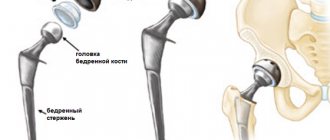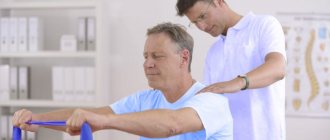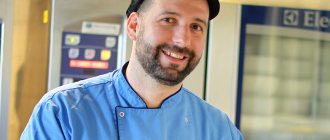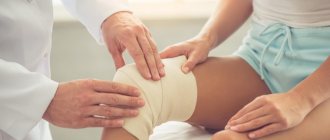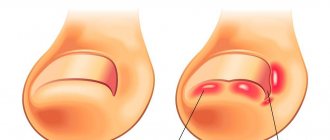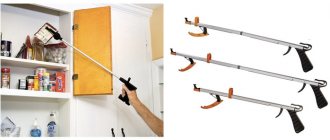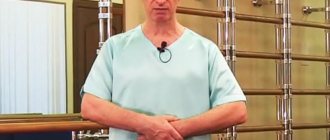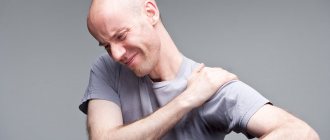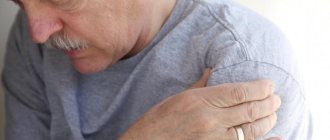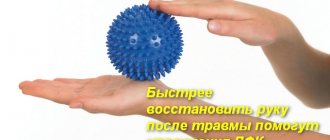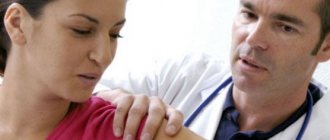- CPM therapy is a method of developing a joint using a special device that does not require active contraction of the periarticular muscles.
Traditional treatment of glenohumeral joint injury
Shoulder injuries – in most cases, surgery is required;
stable osteosynthesis or complete endoprosthetics. Osteosynthesis is the joining of bone fragments (ends) in the correct position with metal fixators (plates, screws, rods), and endoprosthetics is the complete replacement of a joint with an artificial one. Traditional postoperative rehabilitation of shoulder joint injuries usually includes exercise therapy, massage and physiotherapeutic procedures. Go to equipment rental!
Go to the ARTROMOT equipment catalog!
A conservative (non-operative) method of treating shoulder fractures involves applying splints (plaster) and administering painkillers. After the cast is removed (that is, after a long period of time), the patient is given the same prescriptions as postoperative patients with injuries of the shoulder joint.
Rehabilitation after dislocations, severe bruises and muscle tears of the shoulder is carried out approximately according to the same scheme as for a fracture (injury) of the shoulder - rehabilitation : it includes a course of physiotherapy, physical therapy, massages and the use of local ointments. Development of the shoulder joint after fractures and injuries is one of the first tasks of early shoulder rehabilitation.
Deforming arthrosis has a chronic course, and the patient can be completely relieved of pain and function restored only by endoprosthetics, in which the joint is replaced with a metal structure. In this case, rehabilitation will be the same as after surgical treatment of a fracture.
Shoulder fractures (injuries) – rehabilitation: disadvantages of traditional rehabilitation methods
Unfortunately, traditional methods of rehabilitation take a person out of his usual way of life for a long time: he is seriously limited in his movements and is forced to forget about work for a long time. At the same time, he needs money not only no less, but much more than a healthy person, because serious and long-term treatment always requires us to spend a lot of money.
In addition, it is almost impossible for a person with a serious fracture to visit the clinic every day, so most patients have to hire private massage therapists and exercise therapy instructors. Physiotherapeutic procedures at home, as a rule, are not carried out.
As for physical therapy exercises, the physical activity necessary to develop joints in most cases causes severe pain. Many patients have a subconscious reluctance to move again, which ultimately leads to the development of all sorts of complications.
An alternative to traditional methods of rehabilitation after joint injuries
In the West, innovative methods of rehabilitation have long been widespread, which allow a person to get back on his feet in a very short time. Now the possibility of a quick recovery has appeared for Russian patients - this is a rehabilitation system called CPM therapy (Continuous Passive Motion). The essence of the method comes down to developing the joint through “passive action”. “Passive action” is a movement performed with the help of a special apparatus and does not require active contraction of the periarticular muscles. This rehabilitation method allows you to keep the patient's joints mobile without causing him to feel pain and discomfort.
Alternative to plaster cast
German orthopedic products are very popular all over the world, as they are an alternative to plaster splints and, in some cases, allow one to avoid surgical intervention. ORMED bandages, corsets and knee pads do not restrict the patient’s movements and do not cause discomfort. Supporting and strengthening devices ARTROMAXX and ARTROCARE differ from cheaper orthopedic products in their ease of wearing and long service life.
Shoulder rehabilitation
Restoring the shoulder joint following an injury (fracture, complicated dislocation) and surgery is a long and complex process that requires patience from the patient – and professionalism and an individual approach from the rehabilitation doctor. Rehabilitation uses methods of drug therapy, exercise therapy, physiotherapy and massage. At the same time, it is important to regularly monitor vital signs - blood pressure, pulse, temperature, in order to know how the patient’s body reacts to the procedures in the process of restoring the functions of the damaged joint.
Causes
The bones, ligaments and tendons that make up the shoulder joint are enclosed in a capsule of connective tissue. Frozen shoulder occurs when this capsule thickens and contracts around the shoulder joint, limiting its movement. The risk of developing frozen shoulder (FF) is higher in patients who have not regained full range of motion - post-operative patients, people who have had a stroke or mastectomy. The course of the disease and consequences are very variable and this makes it difficult to study and treat.
“Most therapeutic and medical treatments for adhesive capsulitis have clinical benefit when combined with other treatments.”
Rehabilitation after injuries to the shoulder joint
After an injury, during treatment, the shoulder joint needs immobilization - immobilization. Fixation of the joint is resorted to when:
- Fractures of the shoulder joints;
- Dislocation of the joint;
- Torn ligaments, tendons, muscles;
- Performing surgery after fractures or complicated dislocations of the shoulder joints.
Depending on the complexity of the injury and the duration of immobilization of the joint, the recovery time varies. The longest rehabilitation period is for shoulder arthroplasty - the recovery process takes 3-4 months, and sometimes more. Also considered difficult cases are damage to the articular labrum, hyaline cartilage tissue, and the synovial membrane of the joint capsule.
Separately, it is worth mentioning about bone cracks - such injuries are no less dangerous than fractures, as they often remain undiagnosed and are fraught with serious complications. The correctly carried out stage of rehabilitation will determine whether the crack will develop into a full-fledged fracture and whether the motor function of the limb will be impaired in the future.
Why choose us
Gym and Wi-Fi
Guests and visitors can use free Wi-Fi. And for those who want to exercise, our boarding house has a gym.
Air conditioning and TV
We provide comfortable living conditions for all our guests. Try staying for at least a week and you will love it!
Medical equipment
We have all the necessary equipment to maintain your health, and our attentive staff will provide assistance if necessary.
Board games and books
A large selection of books and board games is freely available for our guests. The staff gives regular health lectures.
After surgical treatment of the shoulder joint.
Does your shoulder hurt and is it difficult to raise your arm? Frozen shoulder syndrome is dangerous!
Do you have difficulty raising your arm (especially to the side) and have aching pain in your shoulder? Perhaps this is adhesive capsulitis. This is a very dangerous disease ,
which at the initial stage
leads to limited
mobility and damage to the joint capsule.
In this case, the function of the arm can only be restored
through shoulder replacement surgery, which can lead to disability.
Can this be avoided? Yes, you can!
You will return to your normal life 6 times faster!
Take advantage of the unique author's physical rehabilitation program in a special hall of the clinic.
Everything was calculated to the minute. You will not waste a minute of extra time in the clinic. 2,910 minutes - duration of the rehabilitation program
.
Now you have a unique opportunity to take advantage of the rehabilitation program with a benefit of RUB 25,658
.
| 19 days | Forms of rehabilitation (3 consultations, 10 procedures, 10 classes in the exercise therapy room) | |
| 1 day | Reception and consultation with a physical therapy doctor on creating an individual rehabilitation program in the physical therapy room. | 30 min |
| Myofascial release | 30 min | |
| Classes on the Kinetec device under the guidance of a physical therapy instructor | 60 min | |
| Day 3 | Myofascial release | 30 min |
| Classes on the Kinetec device under the guidance of a physical therapy instructor | 60 min | |
| 5 day | Appointment and consultation with a physical therapy doctor: re-examination, adjustment and finalization of the plan. | 30 min |
| Myofascial release | 30 min | |
| Classes on the Kinetec device under the guidance of a physical therapy instructor | 60 min | |
| Day 7 | Myofascial release | 30 min |
| Classes on the Kinetec device under the guidance of a physical therapy instructor | 60 min | |
| Day 9 | Myofascial release | 30 min |
| Classes on the Kinetec device under the guidance of a physical therapy instructor | 60 min | |
| 10 day | Final consultation with a physical therapy doctor: drawing up an individual post-course program of preventive and supportive measures. | 30 min |
| Day 11 | Myofascial release | 30 min |
| Classes on the Kinetec device under the guidance of a physical therapy instructor | 60 min | |
| Day 13 | Myofascial release | 30 min |
| Classes on the Kinetec device under the guidance of a physical therapy instructor | 60 min | |
| Day 15 | Myofascial release | 30 min |
| Classes on the Kinetec device under the guidance of a physical therapy instructor | 60 min | |
| Day 17 | Myofascial release | 30 min |
| Classes on the Kinetec device under the guidance of a physical therapy instructor | 60 min | |
| Day 19 | Myofascial release | 30 min |
| Classes on the Kinetec device under the guidance of a physical therapy instructor | 60 min | |
| Total: | 960 min. | |
Package offers for rehabilitation from RUB 2,000.
| Services | Cost, ₽ |
| Rehabilitation after surgery on the shoulder joint | 58 564 66 550 |
Rehabilitation of the shoulder joint after surgery
Rehabilitation of the shoulder joint after surgery is carried out exclusively by experienced rehabilitation doctors: the recovery time, the complex of rehabilitation measures and the intensity of the load depend on the reason for which the patient was operated on. So, operations are carried out when:
- Fractures of the shoulder joints;
- Impaired functioning of the rotator cuff;
- Instability of the shoulder joints, including after dislocations;
- Subacromial conflict syndrome.
On average, the recovery period after surgery is 6 months - during this time, motor activity, ligament and muscle function are completely restored. The duration of the rehabilitation period increases in the presence of complications or unsatisfactory general condition of the patient. An older person may need more time.
A standard rehabilitation program is aimed at achieving two main goals - improving coordination and restoring muscle strength, and looks like this:
- Early stage – even during immobilization, passive movements are carried out. The patient tries to move the fingers of the operated limb. For two weeks after immobilization, work of the muscles of the shoulder joint should be performed against resistance, and at a slow pace. To relieve reflex tension, the patient is prescribed massage and physiotherapeutic procedures. Therapeutic treatment consists of prescribing non-steroidal anti-inflammatory drugs and vitamin and mineral complexes.
- The next stage is aimed at increasing dynamic and static loads. From simple movements they move on to complex ones, requiring increased coordination and the use of additional weights. At this stage of rehabilitation, special simulators Biodex and Primus are used.
Rehabilitation after osteosynthesis of the humerus
Osteosynthesis is the most effective method for healing humeral fractures. However, without subsequent rehabilitation there is no hope for a full recovery.
Thanks to the use of modern technologies during surgery, rehabilitation can begin in the early postoperative period, despite the fact that the therapy will be painful at first. This is a prerequisite in order to restore full function of the joint.
The initial stage of rehabilitation must be agreed upon with the attending physician, who, depending on the complexity of the operation, will predict the effect of therapy.
During the first week after surgery, the patient feels swelling of the arm, pain, and possibly an increase in body temperature. It is recommended to relieve pain with painkillers. Dressings are carried out within three days after the operation. On average, the stitches are removed after two weeks.
At the first stage of restoring the functions of the joint, simple exercises are shown: flexion and extension, circular movements, raising and lowering the arm.
A systematic approach is required: therapeutic exercises must be carried out 6-8 times daily. As the joint develops, exercises with an expander, ball, and dumbbells are added. If possible, it is better to exercise under the supervision of a specialist.
The problem of postoperative rehabilitation must be approached comprehensively: physical activity must be combined with physiotherapy, a swimming pool, massages and adherence to the diet recommended by the doctor. These activities improve blood circulation and muscle trophism, and help prevent pain.
Discomfort in the shoulder joint may persist for three months. The patient should not carry heavy bags. At first, the joint will not fully extend, movements will be constrained and accompanied by pain, which is especially noticeable in the morning after a night's rest. Gradually the unpleasant symptoms will disappear.
The scar after osteosynthesis surgery will be thickened and red. It is recommended to use ointments with local analgesic and anti-inflammatory effects. Over time, the scar will become less noticeable. In order to prevent the formation of keloid scars and speed up the process of tissue regeneration, the patient is recommended to undergo laser scar correction.
The use of modern titanium metal structures makes it possible to monitor the fusion of the shoulder joint using X-rays and computed tomography without risk to the patient’s health.
At the request of the patient, after 1-1.5 years it is possible to perform an operation to remove the metal structure.
***
In our center, consultations are conducted by orthopedic traumatologists with many years of practical experience. These are fans of their field who keep their finger on the pulse of all current research and new treatment methods.
All traumatologists at our center are active surgeons. However, we do not have the goal of imposing surgical treatment on every patient. We are experts in our field and it is important for us to maintain this status. This can only be achieved by caring for each patient and the most accurate selection of effective and safe treatment.
To make an appointment with an orthopedic traumatologist, call or fill out the following online form.
Rehabilitation after a shoulder fracture
The shoulder joint is most at risk of fracture because it is involved in many movements and takes on a lot of stress. Recovery after a fracture of the shoulder joint is a fairly long process, but recovery time is reduced if the patient is in the capable hands of an experienced rehabilitator.
Recovery consists of using a set of measures - therapeutic, massage, physiotherapy and exercise therapy. The rehabilitation period begins even during immobilization of the limb - first with passive movements in the joints, then expanding them and making them more dynamic. In the process of developing the joint after removing the fixing bandage, you can use exercise machines and exercise in the pool. Therapeutic treatment involves the prescription of non-steroidal anti-inflammatory drugs (for pain), vitamin and mineral complexes.
It should also be noted that there are a number of features that should also be taken into account during the rehabilitation process after a fracture of the shoulder joint:
- All physical exercises should be progressive, the load should be increased progressively. You should start with the simplest, uncomplicated exercises that strain the muscles to a lesser extent. After mastering the basic movements, you can smoothly move on to classes with additional equipment: weights, gymnastic sticks.
- It is important to warm up and do a full-fledged physical exercise with both the sore arm and the healthy one.
- Physical therapy should be carried out on a regular basis; it is not recommended to skip classes in order to prevent the muscles from relaxing. Regular training will gradually tone all the necessary ligaments, muscle tissue and improve blood circulation.
- You should not be afraid of slight pain, as this is a normal reaction of renewed and healed muscle tissue to forgotten movements. If you feel discomfort, you should pause in the exercises.
The rehabilitation specialist will best prepare and conduct all the necessary classes for effective recovery after a fracture of the shoulder joint. Qualified specialists and professional equipment will help not only restore your sore arm quickly, but also maintain the final result for a long time.
Shoulder rehabilitation after a fracture with equipment from Ortorent
A shoulder fracture is an injury that is not common. However, if it occurs, specific treatment and rehabilitation after a shoulder injury . The success of recovery depends on how the rehabilitation period goes.
In modern medicine, many types of rehabilitation measures are used. Mechanotherapy shows the greatest effectiveness.
CPM therapy in the development of the shoulder joint
CPM therapy has become widespread in modern medicine. This is a truly innovative technique that uses special medical simulators. Their work is based on the method of passive influence. This means that the periarticular muscles will not contract actively and experience heavy loads. The movement of the limb is performed using a medical mechanical device.
This technique allows:
- to effectively develop the shoulder joint after a fracture ;
- restore limb mobility;
- undergo pain-free recovery.
Recovery after a shoulder dislocation
When treating dislocations, some patients ignore the doctor’s recommendations about taking a course of exercise therapy, massage and physiotherapy, because they believe that a dislocation is not as serious an injury as a fracture. This erroneous opinion and neglect of rehabilitation procedures is fraught with serious complications, the most dangerous of which is impaired mobility and function of the joint.
A complex of exercise therapy is necessary for the development of the joint, but the patient will not be able to regulate the intensity of the load on his own, so physical therapy is carried out in specialized centers under the supervision of a doctor. The specialist pays special attention to turning the joint outward and inward. Exercise therapy is complemented by physiotherapy, exercise equipment, and massages. Physiotherapeutic techniques involve the use of UHF, phonophoresis, electrical stimulation, shock wave therapy, etc.
Reviews from our clients
I play tennis professionally and am a frequent visitor to Baltic.
Thank you very much, guys, for this approach to work, for your attention and professionalism. You are best. Oleg
A pediatric traumatologist advised my 16-year-old son and I to contact Baltiyskiy with the problem of habitual dislocation. After completing the massage course, the situation improved significantly; no problems have arisen for more than 1.5 years.
Elena Sergeevna V.
Shoulder joint treatment
Examples of treatment are not limited to chiropractic care, exercise therapy, a home stretching program, physical therapy, and corticosteroid injections. Joint mobilizations using progressive levels of pressure are the most common manual therapy techniques in the treatment of ZP. Axial traction (distraction), the purpose of which is to increase joint space, is an auxiliary technique of manual therapy.
To implement the best possible treatment, the patient must be fully involved in the therapeutic process. This is required to perform daily exercises aimed at increasing mobility, strengthening the muscles of the shoulder girdle and stretching. It is imperative that the therapist and patient take sufficient time to complete education about the importance of rehabilitation and its components.
Clinicians at the SportClinic are familiar with evidence-based medicine and confidently use a variety of treatment methods for celiac disease. Our rehabilitation therapists use a combination of clinical judgment, experience and science to apply a variety of manual therapy techniques, exercises to strengthen and develop shoulder girdle movement, improve daily ergometry and create a self-paced individual program for the patient. In many difficult cases, the use of active physical rehabilitation may be the most successful treatment approach.
The video provides examples of exercises for stretching and strengthening the shoulder girdle, which are part of the patient's individual program.
Rehabilitation of exercise therapy of the shoulder joint
Exercise therapy is the main tool in the treatment of the shoulder joint after injuries. All types of exercises can be divided into 2 groups - active and passive.
The passive elements of exercise therapy include kinesiotherapy. It is aimed at restoring the joint, eliminating swelling, and relieving pain. Active rehabilitation is carried out in order to form a full-fledged muscle corset and completely restore motor activity. All exercises in this phase of rehabilitation should also be performed under the supervision of a physician.
There is also a conditional division of exercises into complexes, each of which has its own focus and main advantages. One such set of exercises is isometric exercises . The main objective of this type of exercise is to eliminate pain in the joint by alternating movements aimed at tension and relaxation of the damaged shoulder joint.
There are also a number of static exercises , during which the patient needs to maintain one position for a certain period of time. This method allows you to provide tension in a certain part of the body on a permanent basis. Thus, when maintaining a specific position, a number of muscles are involved in the work, supporting the shoulder joint.
Don't forget about dynamic exercises - intense movement of certain parts of the body. When performing most dynamic exercises, not only the sore arm is used, but also the core, legs and a large number of other important muscles. The dynamic nature of the movement also leads to tension in the muscles, stimulating their growth, which better allows the restoration of the basic functions of the shoulder joint. The dynamic cycle is recommended to be performed at the end of the entire set of exercises.
A set of exercises after shoulder surgery
Regular exercise to restore proper range of motion and flexibility, as well as a gradual return to daily work and recreational activities, is important for full recovery.
Your podiatrist and physical therapist may recommend that you exercise for 10 to 15 minutes, 2 or 3 times a day, during the initial recovery period. Some of the following exercises are recommended.
This guide will help you better understand your exercise and movement program.
Circular and pendulum movements
Lean forward, bending your torso at a 90-degree angle, using a chair as support.
Rock your body in a circular motion so that your shoulder moves 10 times clockwise and then 10 times in the opposite direction.
Perform 3 sets of movements daily.
Shoulder Stretch (Exercise using the other arm)
Place your hands together and raise them above your head. The exercise can be performed in a lying position (Figure A) or sitting (Figure B). Keep your elbows as straight as possible. Repeat 10 to 20 times. Perform 3 sets of movements daily.
Shoulder rotation with support
Place your elbow in one place on the table and lower your shoulder blades and keep them together. Move your forearm back and forth.
Repeat 10 times.
Perform 3 sets of movements daily.
“Climbing” to the top (Active exercise)
Keep your elbow straight and use your fingers to “climb” along the wall or door lintel as high as you can.
Hold your hand in the up position for 10 seconds. Repeat 3 times.
Perform 3 sets of movements daily.
Shoulder internal rotation (Active exercise)
Place your hand behind your back and reach towards the opposite side of your body.
Repeat 10 times.
Perform 3 sets of movements daily.
Shoulder Curl (Active Exercise)
Raise your arm toward the ceiling, keeping your elbow straight. Hold the position for 10 seconds.
Repeat 3 times.
Perform 3 sets of movements daily.
Bringing the arm to the body (Active exercise)
Raise your arm to the side, straighten your elbow and turn your palm down. Without moving your shoulder or tilting your torso, hold the position for 10 seconds.
Repeat 3 times.
Perform 3 sets of movements daily.
Shoulder Stretch (Isometric Exercise)
Stand with your hands on the wall, arms extended on both sides of your body.
Keeping your elbows straight, press your hands against the wall.
Hold the position for 5 seconds and then relax your muscles.
Repeat 10 times.
Shoulder Internal Rotation (Isometric Exercise)
Stand with the operated side of your body leaning against the wall.
Bend your elbow at a 90-degree angle.
Press your shoulder against the wall. Hold the position for 5 seconds, then relax your muscles.
Repeat 10 times.
Shoulder Internal Rotation (Isometric Exercise)
Stand on the corner of a wall or near a doorway. Place your operated shoulder against a wall at a corner, bending your elbow at a 90-degree angle.
Press your hand against the wall. Hold the position for 5 seconds, then relax your muscles.
Repeat 10 times.
Shoulder internal rotation
Lying on your side, bend your elbow at a 90-degree angle. Take a small dumbbell in your hand and raise your arm towards your stomach. Slowly lower your hand.
Repeat 10 times.
Perform 3 sets of movements daily.
Shoulder external rotation
Lying on your side, keep your elbow bent at a 90-degree angle. Holding a small dumbbell, raise your arm away from your stomach. Slowly lower your hand.
Repeat 10 times.
Perform 3 sets of movements daily.
Bringing the arm to the body (Isometric exercise)
Press your elbow into a small pillow placed on the side of your body. Hold the position for 5 seconds.
Repeat 10 times.
Perform 3 sets of movements daily.
Abduction of the arm from the body (Isometric exercise)
Moving up and to the side, press your hand on the back of the chair. Hold the position for 5 seconds.
Repeat 10 times.
Perform 3 sets of movements daily.
Complete restoration at the Baltiysky boarding house
The St. Petersburg Rehabilitation Medical Center successfully rehabilitates patients after injuries to the shoulder joint. Our specialists deal with injuries of any complexity. Hand joints are especially often affected by injuries among athletes and people involved in heavy work. If high-quality rehabilitation is not carried out, a person may lose the ability to fully use his hand for life. Our center uses advanced methods for restoring arm mobility in adult patients of any age, including the elderly.
Rehabilitation after shoulder replacement
provides rehabilitation for patients after shoulder replacement. Medical is a set of effective measures aimed at strengthening the physiological, psychosomatic health of patients and returning to a full life.
A highly effective operation eliminates disability and makes it possible to restore normal strength, rhythm, coordination, and stability of movements of the upper limb, which has been confirmed by numerous clinical studies. Thanks to shoulder arthroplasty, flexion and extension of the corresponding part of the musculoskeletal system, abduction and adduction, and internal and external rotation become available. Moreover, what is especially important, movements in all planes are carried out painlessly and in full.
If previously it cost a person a lot of work and terrible suffering, for example, to put his hand behind his head or back in the slightest degree, move it to the side, lift it up or hold even the lightest object, then after installing the endoprosthesis, you can really forget about all these difficulties. However, it is not enough to solely replace the joint; the patient needs to work hard on his recovery afterwards in order to definitely get an excellent positive effect from the surgical procedure.
The maximum return of motor potential is facilitated by rehabilitation after shoulder arthroplasty, which plays a role no less significant than the operation itself. Only after qualitatively going through the entire path of postoperative rehabilitation can a person count on a favorable prognosis - restoration of the functionality of the operated area by 95% -100%. Of course, provided that the prosthetics were performed without flaws - at the highest professional level.
As for the quality of the procedure itself, you will be provided with it if you are operated on in a good orthopedic clinic abroad, where the entire surgical process is worked out and refined to the smallest detail. Therefore, it is fundamentally important to ensure that endoprosthetics, which is ideal in every sense of the word, is not done in vain, and to continuously develop a new shoulder joint in accordance with all the rules and regulations. Postoperative treatment is carried out in stages according to a specially designed scheme, it takes at least 3 months.
Why do you need rehabilitation after a shoulder injury?
Our body is a self-regulating and unique, complex system that has significant reserves and compensatory capabilities. At the same time, what is not used by us for a long time is naturally limited and removed. Even a slight temporary restriction of joint mobility (for example, immobilization in a plaster splint) leads to the formation of contracture.
On the other hand, excessive activity immediately after injury or surgery can lead to a deterioration in the regeneration process and failure of the reconstructed tissue, with all the ensuing consequences and problems. An optimal comprehensive recovery program, designed taking into account the type of injury or operation, individual characteristics and timing, allows the patient to consistently navigate between these two dangers and prevent possible complications.
What is rehabilitation and how long does it take?
The first exercises should be started 1-2 days after the intervention. During the first six to eight weeks, you should gradually increase the range of motion of the operated joint.
During this time, complete restoration of muscles, skin, tendons and bones will occur, which will allow you to begin performing already active strengthening exercises.
During the first recovery period after surgery, the following recommendations should be followed:
- Do not lift anything heavier than a glass of water with your hand;
- At least 4-5 times a day, perform physical exercises, a list of which will be given by your doctor;
- When getting out of a chair or bed, do not help yourself with your sore arm;
- Try to use the new joint as little as possible when performing everyday activities;
- Do not stretch your arm back or move it to the side;
- Do not drive a car;
- Wear a scarf at night;
- Try to agree with your loved ones to help with cleaning, cooking and other work at first.
One and a half months after shoulder arthroplasty, it is recommended to consult with your doctor and if there are no contraindications, you can begin resuming moderate sports activities and performing certain activities with a load on the shoulder joint.
Full return to normal activities occurs 12-24 weeks after endoprosthetics. After this time, you can resume work, cycling, swimming and other sports that do not put a lot of stress on the shoulder joint.
However, even after the completion of the rehabilitation period, it is recommended not to subject the artificial joint to heavy loads, as this will lead to its premature wear and the need for revision surgery (a similar thing is required in case of a bone fracture around the implant, which can occur due to an unsuccessful fall or any injury).
Rehabilitation in St. Petersburg after a stroke offers an extensive range of treatment and recovery services. We have reasonable prices and comfortable conditions for round-the-clock stay of patients of any severity. The staff of the Northern Riviera sanatorium includes experienced neurologists, cardiologists, physiotherapists, speech therapists, physical therapy doctors, and massage therapists. If you need to undergo rehabilitation after a stroke, call us!
Prices for rehabilitation services
Cost of stay from 1500 rub. day.
| Services list | Cost of services |
| Initial consultation with a therapist for residents | For free |
| Consultation with a specialist doctor | 1500 |
| Speech therapist | 1500 |
| Psychologist | 1500 |
| Manual therapy | 1500 |
| Electrocardiogram with interpretation | 900 |
| Ultrasound examination (ultrasound) | 1000 |
| Physiotherapeutic procedures | 700 |
| Physiotherapy | 750 |
| General massage (back, neck) | 1000 |
| Foot massage | 600 |
| Hand massage | 400 |
| IV | 700 |
| IV administration of drugs | 300 |
| IM administration of drugs | 250 |
| Setting up a cleansing enema | 300 |
| Laboratory diagnostics | According to the price list |
